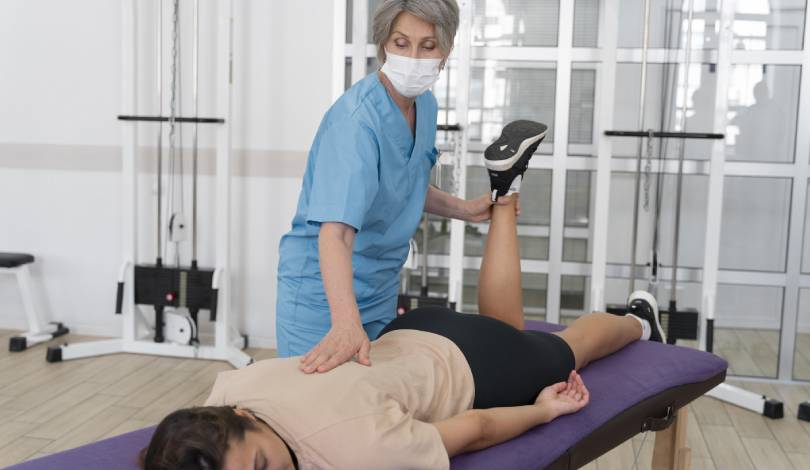Synopsis
Lower back pain is a common issue that can significantly impact daily life, limiting movement and causing discomfort. Fortunately, physiotherapy for lower back pain offers effective, non-invasive treatments that help restore mobility and reduce pain. This blog explores eight proven techniques in physical therapy treatment for back pain, including stretching, strengthening exercises, and manual therapy. We’ll also cover how physio for sore back targets muscle imbalances and improves posture, while back pain physical therapy treatment helps prevent future injuries. Whether you’re dealing with chronic pain or recovering from an injury, the right physio for back pain can provide long-term relief and enhance your quality of life. Discover how backache physiotherapy can help you regain mobility and live pain-free.
Table of Contents
- Understanding the Causes of Lower Back Pain
- Stretching Exercises for Flexibility and Pain Relief
- Strengthening Exercises for Core Stability
- Manual Therapy for Reducing Tension and Improving Movement
- Posture Correction for Long-Term Back Health
- Mobility Exercises to Restore Full Movement
- Ergonomic Adjustments to Prevent Future Pain
- Orthocure’s Approach to Treating Lower Back Pain
- Conclusion- Long-Term Benefits of Physiotherapy for Lower Back Pain
Understanding the Causes of Lower Back Pain
Lower back pain can arise from various causes, including poor posture, muscle strain, herniated discs, or degenerative conditions like arthritis. Prolonged sitting or standing in incorrect positions can lead to tension and stiffness in the lower back. Physiotherapy for lower back pain focuses on addressing the root causes of discomfort, helping to alleviate pain while improving mobility. Physiotherapists conduct a thorough assessment to determine the specific cause of the pain and create a personalized treatment plan that targets the underlying issue.
Stretching Exercises for Flexibility and Pain Relief
Stretching is a key component of physio for sore back treatments. Stretching exercises improve flexibility and reduce stiffness in the muscles surrounding the lower back. Common stretches such as hamstring, pelvic tilts, and knee-to-chest stretches effectively lengthen tight muscles, allowing for better movement and reduced pain. Regular stretching helps maintain flexibility and prevents the recurrence of lower back pain.
Strengthening Exercises for Core Stability
Strengthening the core muscles is essential for maintaining lower back health. Back pain physical therapy treatment often includes exercises that target the muscles supporting the spine, such as the abdominals, glutes, and lower back muscles. Exercises like planks, bridges, and leg raises help stabilize the spine, reduce pressure on the lower back, and prevent future injuries. Strengthening the core ensures the spine remains well-supported, allowing patients to perform daily activities without discomfort.
Manual Therapy for Reducing Tension and Improving Movement
Manual therapy is a hands-on approach that physiotherapists use to manipulate joints, muscles, and soft tissues in the lower back. Techniques like spinal mobilization, myofascial release, and massage help relieve tension, improve blood circulation, and reduce pain. Physical therapy treatment for back pain often involves manual therapy to increase mobility in the lower back and alleviate discomfort caused by tight muscles or joint misalignments. Regular manual therapy sessions provide immediate relief and contribute to long-term improvements in back function.
Posture Correction for Long-Term Back Health
Poor posture is a common cause of lower back pain. Slouching while sitting or standing can place excessive pressure on the spine, leading to muscle imbalances and pain. Backache physiotherapy includes posture correction to help patients maintain proper spinal alignment. Physiotherapists teach patients how to sit, stand, and move correctly to reduce strain on the lower back. By improving posture, patients can prevent the recurrence of pain and improve their overall back health.
Mobility exercises are designed to improve the range of motion in the lower back and surrounding muscles. Physio for back pain often includes mobility exercises like cat-cow stretches, lumbar rotations, and hip flexor stretches to enhance flexibility and reduce stiffness. These exercises target specific areas of tension and help patients regain full movement in the lower back. Regular mobility exercises are crucial for maintaining flexibility and preventing future episodes of back pain.
Ergonomic Adjustments to Prevent Future Pain
Making ergonomic adjustments to your workspace or daily routine can significantly reduce the risk of lower back pain. Physiotherapists often guide how to adjust chairs, desks, and computer screens to ensure proper posture and minimize strain on the lower back. Simple changes, such as using a lumbar support pillow or adjusting the height of your monitor, can make a big difference in preventing back pain. Incorporating these adjustments into your daily routine helps maintain a healthy back and prevents further issues.
Orthocure’s Approach to Treating Lower Back Pain
At Orthocure Clinics, we provide personalized back pain physical therapy treatment designed to address each patient’s unique needs. Our experienced physiotherapists use stretching, strengthening, and manual therapy techniques to help patients recover from lower back pain. We focus on long-term solutions that improve mobility, reduce pain, and prevent future injuries. We aim to ensure every patient achieves lasting relief and enjoys a pain-free life.
Conclusion- Long-Term Benefits of Physiotherapy for Lower Back Pain
In conclusion, physiotherapy for lower back pain offers a comprehensive, non-invasive approach to managing and preventing discomfort. Through stretching exercises, core strengthening, manual therapy, and posture correction, patients can experience lasting relief and improved mobility. Working with a skilled physiotherapist ensures that each treatment plan is tailored to the individual’s needs, leading to long-term back health and a better quality of life.
What are the most effective physiotherapy techniques for lower back pain?
Physiotherapy for lower back pain involves a combination of stretching exercises, core strengthening, manual therapy, and posture correction. Stretching helps reduce muscle stiffness while strengthening exercises improve core stability to support the spine. Manual therapy techniques like massage and spinal mobilization help alleviate pain by reducing muscle tension and increasing mobility. Posture correction ensures that patients maintain proper alignment to prevent future episodes of lower back pain.
How long does it take to see results from physiotherapy for lower back pain?
The timeline for recovery varies depending on the severity of the lower back pain. Many patients notice mobility and pain relief improvements within a few weeks of consistent physiotherapy sessions. However, long-term relief may require ongoing therapy and exercises performed at home. A comprehensive treatment plan that includes regular physiotherapy sessions and home exercises is essential for lasting results.
Can physiotherapy help prevent future lower back pain?
Yes, physio for back pain is highly effective in preventing future episodes of lower back pain. By strengthening the core muscles, improving posture, and incorporating stretching exercises into daily routines, patients can reduce their risk of experiencing recurring pain. Physiotherapists also provide valuable guidance on adjusting workspaces and daily habits to prevent strain on the lower back.
How does manual therapy help with lower back pain?
Manual therapy involves hands-on techniques that manipulate the muscles and joints in the lower back to reduce tension and improve movement. Techniques such as spinal mobilization, massage, and myofascial release are commonly used in back pain physical therapy treatment. These methods help increase blood circulation, reduce stiffness, and promote tissue healing, providing immediate relief from lower back pain.
What should I expect during my first physiotherapy session for lower back pain?
During your first physiotherapy session, the therapist will assess your posture, range of motion, and pain levels. They will ask about your medical history and any factors contributing to lower back pain, such as daily activities or work habits. Based on this evaluation, the physiotherapist will create a personalized treatment plan that may include stretching, strengthening exercises, and manual therapy. You will also receive guidance on performing exercises at home to support your recovery.





